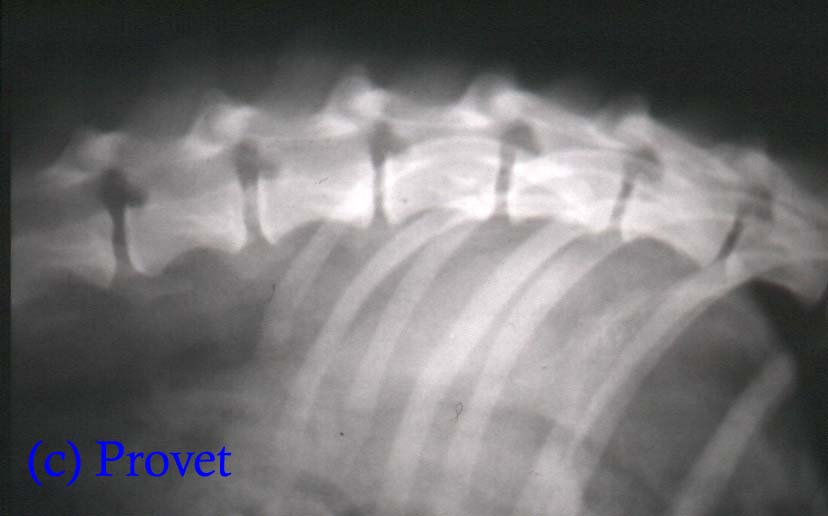 Back
Back
"SLIPPED DISCS " First broadcast on www.provet.co.uk |
This information is provided by Provet for educational purposes only.
You should seek the advice of your veterinarian if your pet is ill as only he or she can correctly advise on the diagnosis and recommend the treatment that is most appropriate for your pet.
Intervertebral discs act like "shock absorbers" between the bones (vertebrae) in the spine. Unfortunately, with advancing age, or following trauma, the disc material can pop out and cause serious back problems - including pain and/or neurological injury.
Flexibility within the spine is important for normal movement, and to make movement easy there are fibrocartilage pads (called discs) located between the bones (vertebrae) that make up the spinal column. The centre of each disc consists of soft gelatinous material. If the outer fibrous part of a disc ruptures this material can pop out, sometimes with considerable force. In humans this is often called a "slipped disc". This can occur in any animal, but some breeds of dog are predisposed to get disc disease (especially dachshunds, but also poodles, cocker spaniels, beagles and others).
The discs undergo degeneration with advancing age, they can rupture due to trauma, and presumably biomechanical pressures cause weakness in the discs in the breeds which are predisposed to develop disc disease - perhaps because of the anatomical design of the spine in some cases eg relatively long backs in dachshunds and beagles.
The signs associated with a slipped disc depend upon where the disc material goes. If it pops out sideways it will cause localised back pain - which can be debilitating, but usually resolves over a period of time with pain relief. If it pops up into the spinal canal it can put pressure on the spinal cord itself , which can result in varying degrees of paralysis. In the worst cases it can cause complete paralysis of the limbs (and sometimes other structures such as the urinary bladder) behind the level of the disc problem. This is because nerves that leave the spine flow backwards and innervate structures behind the point that they leave the spinal cord.
The disease is diagnosed from the clinical signs and XRays (or other medical imaging) which shows a narrowed gap between the vertebrae, calcified discs between the vertebrae (due to degeneration) and disc material within the spinal canal. If the material is calcified it appears on plain XRays, otherwise special contrast has to be injected into the spine to show up areas of compression of the spinal cord (a process called myelography).

An XRay of the spine of a Dachshund showing a narrowed disc space between the (white) vertebrae and disc rupture with calcification
Treatment of slipped discs depends upon the severity of the injury to the spine. In the worst cases the pressure on the spinal cord has to be relieved by surgery (disc fenestration or a laminectomy). In other cases the clinical signs can be controlled using pain killers and anti-inflammatory drugs.
Unfortunately in breeds predisposed to develop disc disease, more than one disc is often affected and recurrent problems of pain, and inability to jump up or negotiate stairs are likely to be seen. If your pet has these signs seek veterinary advice because they cold progress the underlying problem is disc disease.
In the very worst cases irreversible paralysis may result, but providing control of the urinary bladder is still present these patients can often be managed very well - and even be given mobility through specially designed carts (which have been featured on Provet before in connection with treating spinal fractures CLICK HERE).
Updated October 2013